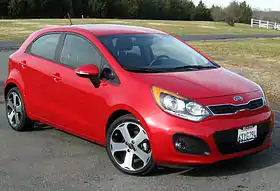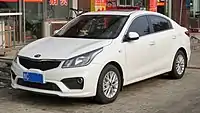Kia Rio
The Kia Rio is a subcompact car produced by the South Korean manufacturer Kia since November 1999 and now in its fourth generation. Body styles have included a three and five-door hatchback and four-door sedan, equipped with inline-four gasoline and diesel engines, and front-wheel drive.
| Kia Rio | |
|---|---|
_S_5-door_hatchback_(2018-08-06)_01.jpg.webp) Fourth generation Kia Rio | |
| Overview | |
| Manufacturer | Kia |
| Also called | Kia Pride (2005–2017) Kia K2 (China; 2011–present) Kia Tonic |
| Production | 1999–present |
| Body and chassis | |
| Class | Subcompact car (B) |
| Body style | 3-door hatchback (2011–2017) 5-door hatchback 4-door sedan/saloon 5-door station wagon (1999–2005) |
| Layout | Front-engine, front-wheel-drive |
| Chronology | |
| Predecessor | Kia Pride Kia Avella |
The Rio replaced the first generation Pride—a rebadged version of the Ford Festiva—and the Avella, a subcompact sold as a Ford in some markets. A second generation was introduced in 2005 in Europe and 2006 in North America, sharing its platform with the Hyundai Accent, a subcompact manufactured by its sister Hyundai Motor Company in South Korea.
First generation (DC; 1999)
| First generation (DC) | |
|---|---|
_LS_hatchback_(2015-11-13)_01.jpg.webp) | |
| Overview | |
| Production | 1999–2005 (South Korea) 2001–2013 (Ecuador)[1][2] 2005–2012 (Iran) |
| Assembly | South Korea: Gwangmyeong (Sohari Plant) Ecuador: Quito (AYMESA) Iran: Tehran (SAIPA) Russia: Kaliningrad (Avtotor) |
| Designer | I.DE.A Institute |
| Body and chassis | |
| Body style | 4-door sedan 5-door station wagon |
| Powertrain | |
| Engine | 1.3 L B3 I4 (petrol) 1.5 L B5-DE I4 (petrol) 1.6 L B6 I4 (petrol) |
| Transmission | 5-speed manual 4-speed F4A-EL automatic |
| Dimensions | |
| Wheelbase | 2,410 mm (94.9 in) |
| Length | 4,215 mm (165.9 in) (2000–02) 4,240 mm (166.9 in) (2002–05) |
| Width | 1,675 mm (65.9 in) (2000–02) 1,680 mm (66.1 in) (2002–05) |
| Height | 1,440 mm (56.7 in) |
_(cropped).jpg.webp)

The first generation Kia Rio (referred internally as the "DC") was offered in both four-door sedan and five-door station wagon body styles. When released, it was the least-expensive mass-produced car to be sold in the United States.[3] While the Rio's styling and affordability were well-received, it was derided for its poor build quality and driving experience.[4]
The station wagon was marketed as the "Rio Cinco" in the United States, "Rio RX-V" in Canada, and "Rio Look" in Chile. The sedan version was not sold in the United Kingdom, and the station wagon was known as the "Rio" there. In Greece, both versions were sold as the "Rio". In South Korea, this was the only generation to use the "Rio" name, as the "Pride" name was used from the second generation onwards.
The first generation Rio offered only one engine for each model year in the United States: a 96 hp (72 kW) 1.5-litre DOHC I4 gasoline engine from 2001 through 2002. Then a larger version appeared, a 1.6-litre DOHC four-cylinder rated at 104 hp (78 kW) used for model years 2003 through 2005. All years offered a choice of a five-speed manual transmission or a four-speed F4A-EL automatic. An alternative of a 1.3-litre (1,343 cc) SOHC four-cylinder/eight-valve petrol, producing 75 hp (56 kW) was offered in some other countries, including the United Kingdom and most of continental Europe. The USA-version five-door featured power steering and a tachometer, optional on the sedan. The European version was marketed under several trim levels; standard equipment for all trims included a driver airbag. Additional features were available for promotion in Greece, including leather seats and car alarm. In Europe, the various national markets received different selections of the three engines.
The domestic Korean market versions did not include the 1.6-liter version, as the South Korean taxation system heavily penalizes cars of more than 1,500 cc. Claimed outputs for the domestic versions (JIS) were higher, at 84 PS (62 kW) for the little 1.3 and 108 PS (79 kW) for the DOHC 1.5.[5] For the SOHC 1.5 95 PS (70 kW) was claimed. The first generation hatchback was marketed as the Rio RX-V in South Korea.
Safety features included seat belts and an airbag for the driver. ABS was available as an option for entry-line cars but fitted by default for top of the range models (i.e., Rio LX, in the UK, and Rio LS, in Greece).
There was a version called the Sports-Pac, which featured a bonnet scoop, a rear wing, golden wheels and blue paint, all inspired by the Subaru Impreza WRX STi. Mechanically the Sports-Pac was identical to regular models, with the exception of lowered suspension.[6]
Facelift

_LS_sedan_(2008-10-26).jpg.webp)


In 2002, the Rio received a mild redesign (for the 2003 model year in the US) including upgrades in engine, suspension, brakes and new exterior and interior styling. After this 2002 facelift the entire range received the "Rio SF" moniker in the domestic South Korean market, with "SF" standing for both "Science Fiction" and "Safety First".
In Europe, the facelifted Rio received minor changes in external look and engine improvement of the 1.3 from 75 hp (56 kW) to 80 hp (60 kW) at 5,500 rpm, and 86 lb⋅ft (117 N⋅m) at 3,000 rpm.
Iranian production of the facelifted Rio by SAIPA began in 2005. The cars were not equipped with ABS or airbags until 2012, powered by a version of the 1.5 litre engine which produces 96 hp (72 kW) at 5,500 rpm and 135 N⋅m (100 ft⋅lbf) torque at 4,500 rpm. In early 2012, the production ended.
Second generation (JB; 2005)
| Second generation (JB) | |
|---|---|
_hatchback_02.jpg.webp) | |
| Overview | |
| Also called | Kia Pride Kia Sephia Sport (Colombia, taxi version) |
| Production | 2005–2011 |
| Assembly | South Korea: Gwangmyeong (Sohari Plant) China: Yancheng (Yancheng Plant) Russia: Izhevsk (IzhAvto) |
| Body and chassis | |
| Body style | 5-door hatchback 4-door sedan |
| Related | Hyundai Accent (MC) |
| Powertrain | |
| Engine | 1.4 L G4EE Alpha II I4 (petrol) 1.6 L G4ED Alpha II I4 (petrol) 1.5 L U-Line I4 (diesel)[7] |
| Transmission | 4-speed automatic 5-speed manual |
| Dimensions | |
| Wheelbase | 2,500 mm (98.4 in) |
| Length | 3,990 mm (157.1 in) (hatchback) 4,240 mm (166.9 in) (2005–09 sedan) 4,250 mm (167.3 in) (2009–11 sedan) |
| Width | 1,695 mm (66.7 in) |
| Height | 1,470 mm (57.9 in) |


_Sports_SE_hatchback_(2010-10-16)_02.jpg.webp)
Kia introduced the second generation (JB) in the early 2005 model year in Europe and for model year 2006 in North America, based on a redesigned platform shared with the Hyundai Accent. The engine was upgraded to a 110 hp 1.6-litre DOHC four-cylinder "Alpha II" engine now also shared with the Hyundai Accent. Other changes include a new exterior design, an increase in exterior size and interior volume, increased safety features and fuel economy. The station wagon was dropped with this generation, replaced by a new 5-door hatchback.
Kia offered the 2006 sedan as the Rio and Rio LX, the LX trim included power steering, air conditioning, and CD player. The Rio5 (USA) offered simply in SX trim level with leather-covered steering wheel. As in the first generation, only the five-door hatchback version was offered in some European markets (including the UK). Three engines are available; a 1.6-litre DOHC engine with 110 hp (82 kW), a lesser 1.4-litre version with 96 hp (72 kW) and a 1.5-litre turbodiesel engine with 109 hp. However, in the US market only the 1.6-litre gasoline engine is offered, in two body styles: a four-door-sedan and a five-door hatch. The European version's common rail diesel engine produces 110 PS (81 kW).
In 2007, an SX trim level was added to the Rio sedan with the same features supplied with the Rio5 SX.
In 2007, the South Korean government began testing approximately 4,000 pre-production Rio hybrid-electric models, with parent company Hyundai Kia Automotive Group later announcing and subsequently withdrawing anticipated release dates for the hybrid model.[8][9]
For 2008, Kia offered the LX trim level for the Rio5 (similar to the Rio LX sedan) and a limited production of Rio5 SX Tuner models, featuring Falken FK452 tires, Tanabe strut tower brace and Eibach Federn lowering springs.[10]
For the 2009 model year, all Rio and Rio5 trims received standard Sirius Satellite Radio (complimentary for three months) and radios with USB port & auxiliary jack, the auxiliary jack substituting for a Bluetooth mobile phone connection for devices with an earphone jack. The Kia Rio ranked 5th in the "20 least expensive 2009 vehicles to insure" list by Insure.com. According to research, the Rio is one of the least expensive vehicles to insure.[11]
For the Malaysian market, the second generation Rio was launched on the 7 September 2005 available with only one trim level with only the hatchback bodystyle and powered by a 1.4-litre 16 valve DOHC engine with a 4-speed automatic gearbox and was fully imported from South Korea.[12][13][14]
Facelift


_%E2%80%93_Heckansicht%252C_3._Juli_2011%252C_Essen.jpg.webp)
For the 2010 model year, the models received a facelift in late 2009, adopting Kia's new Tiger nose grille. In addition, the steering wheel receives the same design as the Kia Soul and Kia Forte, featuring optional Bluetooth hands-free phone operation, and the gauges cluster receives a new red backlit design. The headlights were modified slightly, with a darker appearance and parking lights and side-marker lights sharing the turn-signal housing. Side mouldings on the car became narrower and body-colored. For the UK version, the Rio looks exactly the same as the US version, except that only the hatchback variant is sold there. It has Kia's new 'Tiger Nose' grille (for the 2010 model) and is powered by a 1.4-litre DOHC four-cylinder 16-valve petrol engine, or a 1.5-litre DOHC four-cylinder 16-valve diesel. They both have a five speed manual gearbox.
Safety
- IIHS
The 2006 Rio received Poor to Average ratings from the Insurance Institute for Highway Safety (IIHS).[15]
| Test | Rating |
| Overall: | |
| Moderate overlap front: | Average |
| Side: | Poor |
| Roof strength: | Average |
| Head restraints & seats: | Poor |
- Euro NCAP
Euro NCAP test results for a LHD, 5-door hatchback variant on a 2005 registration:
Third generation (2011)
| Third generation (UB) | |
|---|---|
 | |
| Overview | |
| Also called | Kia Pride |
| Production | 2011–2017 |
| Assembly | South Korea: Gwangmyeong (Sohari Plant) Malaysia: Gurun (NAM) |
| Designer | Peter Schreyer |
| Body and chassis | |
| Body style | 3-door hatchback 5-door hatchback 4-door sedan |
| Platform | Hyundai-Kia PB |
| Related | Kia Pegas/Soluto Hyundai Accent (RB) Hyundai Veloster Hyundai HB20 Hyundai Reina |
| Powertrain | |
| Engine | |
| Transmission | 4-speed automatic 5-speed manual 6-speed A6GF1 automatic 6-speed M6CF1 manual |
| Dimensions | |
| Wheelbase | 2,570 mm (101.2 in) |
| Length | 4,046 mm (159.3 in) (hatchback) 4,366 mm (171.9 in) (sedan) |
| Width | 1,720 mm (67.7 in) |
| Height | 1,455 mm (57.3 in) |
| Curb weight | 1,093–1,141 kg (2,410–2,515 lb) |
Starting from the third generation, the Rio was split into two different models, one being the global model (body code: UB), and the other is a specific model for Russia and China (body code: QB).
Global version (UB)
_SLS_3-door_hatchback_(23816069452).jpg.webp)
_Si_5-door_hatchback_(2015-06-25)_02.jpg.webp)
_Si_sedan_(2016-01-04)_01.jpg.webp)
_Si_sedan_(2016-01-04)_02.jpg.webp)
The third generation UB Kia Rio debuted on March 1, 2011, at the Geneva Motor Show, again based on the Hyundai Accent.
It features 1.4-litre or 1.6-litre Hyundai GDI Gamma engines. The European market also receives the option of a 1.25-litre petrol engine, as well as a 1.4-litre or 1.1-litre CRDi Turbo Diesel Engine - the 1.1-litre engine having the lowest CO2 emissions and highest MPG of any non-electric or hybrid car currently on sale at time of writing; up to 88 mpg on the EU combined cycle (73 mpg in US gallons) and emitting only 85 grams of CO2 per kilometer. This market, however, lacks the 1.6-litre engine, with the 1.4-litre being the most powerful on offer.
Transmission options include a 6-speed manual and 6-speed automatic for the American market, with the European market receiving a 5-speed manual for the 1.25-litre Petrol engine, a 6-speed manual for the 1.4-litre petrol, 1.1-litre and 1.4-litre diesels and a 4-speed automatic for the 1.4-litre petrol "2" spec model in 5-door configuration. Intelligent stop & go is an option on almost all available trim and engine levels.
The Rio in Europe also receives a 3-door model. It is mechanically identical to the 5 door, though its longer doors give it a more sporting appearance that appeals to younger audiences. The 3 door is also noticeably cheaper than the 5 door.
A one time, limited delivery of 50 top-spec European 3-door models have been shipped to New Zealand based on the UK "3" trim and marketed as the Rio Sport EX. The imported European models have a better spec than the current car available in New Zealand, with some extra options added over the European car (such as keyless go), with the limited availability designed to make the car feel exclusive.[18][19]
In November 2011, the third generation Rio was awarded Semperit Irish Car of the Year and in December was awarded Carsguide's 2011 Car of the Year award as well, triumphing over many other vehicles including the likes of the Range Rover Evoque and the recently facelifted Ford Territory.
For the Malaysian market, the third generation Rio was launched in January 2013 available with two trim levels (EX and SX) with only the hatchback bodystyle and powered by a G4FA 1.4-litre MPI Gamma engine.[20] The facelift version was launched in Malaysia in May 2015 and was available with only one trim level (SX).[21] The sedan version was launched in January 2016, available with only one trim level and powered by a 1.4-litre four-cylinder engine and a 4-speed automatic transmission. A "X" variant of the sedan was introduced in March 2016.[22]
IIHS
The 2012 Rio received Marginal to Good ratings from the Insurance Institute for Highway Safety (IIHS).[23]
| Test | Rating |
| Overall: | |
| Small overlap front: | Marginal |
| Moderate overlap front: | Good |
| Side: | Average |
| Roof strength: | Good |
| Head restraints & seats: | Good |
Euro NCAP
Euro NCAP test results for a LHD, 5-door hatchback variant on a 2011 registration:
Kia Rio GT
Kia released a turbocharged performance model of the Cee'd, called the Pro_Cee'd GT in Europe in July 2013, and is the company's first ever hot hatch. Rumours have surfaced around the internet that a Rio GT (based on what is known as the Rio 5-door in America, but using the 3-door European configuration) may go into production, giving Kia a true supermini hot hatch to rival the established class leaders; the Ford Fiesta ST, Peugeot 208 GTi and Renaultsport Clio. Rumours were backed up when the European VP for Kia, Benny Oeyen, mentioned that if the Cee'd GT is successful, Kia would put more GT models into production, including the Rio.[25][26]
Gallery
 Facelift Kia Rio 5-door hatchback (front)
Facelift Kia Rio 5-door hatchback (front)_S_5-door_hatchback_(2018-08-27)_02.jpg.webp) Facelift Kia Rio 5-door hatchback (rear)
Facelift Kia Rio 5-door hatchback (rear)_S_3-door_hatchback_(2018-11-26).jpg.webp) Facelift Kia Rio 3-door hatchback
Facelift Kia Rio 3-door hatchback Interior (pre-facelift)
Interior (pre-facelift)
Russian/Chinese version (QB)
| Third generation (QB) | |
|---|---|
_(Front)_(cropped).jpg.webp) | |
| Overview | |
| Also called | Kia K2 (China)[27] |
| Production | 2011–2017 |
| Assembly | China: Yancheng (Yancheng Plant) Russia: St. Petersburg (Hyundai Rus) |
| Body and chassis | |
| Body style | 5-door hatchback 4-door sedan |
| Platform | Hyundai-Kia PB |
| Related | Hyundai Accent/Solaris (RB) Hyundai Reina |
| Powertrain | |
| Engine | Petrol: 1.4 L Gamma MPi I4 1.6 L Gamma MPi I4 |
| Transmission | 5-speed manual 6-speed manual 4-speed automatic 6-speed automatic |
| Dimensions | |
| Wheelbase | 2,570 mm (101.2 in) |
| Length | 4,120–4,125 mm (162–162 in) (hatchback) 4,370–4,377 mm (172–172 in) (sedan) |
| Width | 1,700 mm (67 in) |
| Height | 1,470 mm (58 in) |
| Curb weight | 1,115–1,151 kg (2,458–2,538 lb) |
In May 2011, it was announced that Kia would release a modified Kia Rio model being created for Russia. Production began on 15 August 2011 at the Hyundai plant in Saint Petersburg, and the QB Kia Rio was officially released in Russia on 17 August 2011.[28][29] The QB Rio features a more conservative design than the UB Rio. This version was also released to Chinese market, badged as the Kia K2.
 Kia K2 sedan (China, pre-facelift)
Kia K2 sedan (China, pre-facelift) Kia K2 sedan (China, pre-facelift)
Kia K2 sedan (China, pre-facelift) Kia K2 hatchback (China, pre-facelift)
Kia K2 hatchback (China, pre-facelift) Kia K2 hatchback (China, pre-facelift)
Kia K2 hatchback (China, pre-facelift) Kia K2 sedan (China, facelift)
Kia K2 sedan (China, facelift) Kia K2 hatchback (China, facelift)
Kia K2 hatchback (China, facelift)%252C_rear_8.3.18.jpg.webp) Kia K2 hatchback (China, facelift)
Kia K2 hatchback (China, facelift)
Fourth generation (2017)
The fourth generation Rio is also split into two different models, one being the global model (body code: YB), and the other is a specific model for Russia and China (body code: FB/UC).
Global version (YB)
| Fourth generation (YB) | |
|---|---|
 | |
| Overview | |
| Also called | Kia Tonic (crossover version; Colombia)[30] |
| Production | 2017–present |
| Assembly | South Korea: Gwangmyeong (Sohari Plant) Mexico: Pesquería[31] Algeria: Batna (GLOVIZ)[32] |
| Designer | Peter Schreyer |
| Body and chassis | |
| Body style | 5-door hatchback 4-door sedan[33] |
| Platform | Hyundai-Kia GB |
| Related | Kia Stonic Hyundai Accent (HC) Hyundai i20 (GB) |
| Powertrain | |
| Engine | Petrol: 1.0 L Kappa T-GDi I3 1.2 L Kappa MPi I4 1.4 L Kappa MPi I4 1.6 L Gamma GDi I4 1.6 L Gamma MPi I4 Diesel: 1.4 L U-Line TCi (WGT) I4 |
| Transmission | 5-speed manual 6-speed manual 4-speed automatic 6-speed automatic 7-speed DCT |
| Dimensions | |
| Wheelbase | 2,580 mm (101.6 in) |
| Length | 4,065 mm (160.0 in) (hatchback) 4,385 mm (172.6 in) (sedan) |
| Width | 1,725 mm (67.9 in) |
| Height | 1,450 mm (57.1 in) (hatchback) 1,460 mm (57.5 in) (sedan) |
Kia presented the global fourth generation Rio at the 2016 Paris Motor Show. The new car was designed in Kia's California and Germany design centers and features longer front overhangs, a bigger hood and a more upright C-pillar.[34] The hatchback model is 15 mm longer, 5 mm wider and 5 mm shorter in height than its predecessor. Production began by the end of 2016. In European markets, the car is only offered in hatchback form while the U.S. market will receive both hatchback and sedan forms.[35][36] For the North American market, the Rio is manufactured alongside the Kia Forte at the Pesquería plant in Mexico.[31] Unlike the previous generations, the fourth generation Rio is not offered in the South Korean market; instead, the Rio-based Stonic crossover takes its place.
For the North American market, the 1.6-litre Gamma GDI (gasoline direct injection) engine was replaced by the 1.6-litre Gamma 2 MPI (multiport injection) starting from 2020. The EPA fuel economy rating was significantly improved as a result while rated horsepower reduced from a peak 130 to a peak 120 hp.
For the Malaysian market, the fourth generation Rio was launched in July 2017 available with only one trim level with only the hatchback bodystyle and powered by a 1.4-litre naturally-aspirated Dual CVVT four-cylinder engine and a 4-speed automatic transmission. For the 2018 update, a 6-speed transmission replaced the 4-speed transmission and 16-inch alloys replaced the previous 17-inch.[37][38][39]
The facelifted model went on sale in Mexico in October 2020.[40]
A rugged crossover-styled variant was released in Colombia as the Kia Tonic.[41][42]
 Kia Rio hatchback
Kia Rio hatchback.jpg.webp) Kia Rio sedan
Kia Rio sedan Kia Rio GT-Line
Kia Rio GT-Line Kia Rio GT-Line
Kia Rio GT-Line.png.webp) Kia Tonic (crossover version, Colombia)
Kia Tonic (crossover version, Colombia).png.webp) Kia Tonic (crossover version, Colombia)
Kia Tonic (crossover version, Colombia) Interior
Interior 1.4 L Kappa I4 engine
1.4 L Kappa I4 engine
Marketing
For the international release of the Rio and the third generation Kia Picanto, Kia Motors produced two music videos featuring Korean-American singer Kate Kim and American musician Lee Radde in May 2017.[43][44]
Awards
The Rio won the 2017 Red Dot Award for Passenger Car Design[45] and the 2017 iF Design Award for Discipline Product.[46]
Euro NCAP
Euro NCAP test results for a LHD, 5-door hatchback variant with standard equipment on a 2017 registration:
| Test | Points | % |
|---|---|---|
| Overall: | ||
| Adult occupant: | 32.5 | 85% |
| Child occupant: | 41.2 | 84% |
| Pedestrian: | 26 | 62% |
| Safety assist: | 3 | 25% |
Euro NCAP test results for a LHD, 5-door hatchback variant with optional safety pack on a 2017 registration:
Insurance Institute for Highway Safety
IIHS crash test results for an LHD, 4-door sedan variant with standard equipment on a 2018 registration, and won the Top Safety Pick+ award:
| Test | Rating |
| Small overlap front: | Good |
| Moderate overlap front (driver side): | Good |
| Moderate overlap front (passenger side): | Acceptable |
| Side: | Good |
| Roof strength: | Good |
| Head restraints & seats: | Good |
| Front crash prevention: | Superior |
| Headlights (varies by trim/option): | Good |
| Child seat anchors (Latch) ease of use: | Good |
Russian/Chinese version (FB/UC)
| Fourth generation (FB/UC) | |
|---|---|
_(cropped).jpg.webp) | |
| Overview | |
| Also called | Kia K2 (China) Kia KX Cross (crossover version, China) |
| Production | 2017–present |
| Assembly | China: Yancheng (Yancheng Plant) Russia: St. Petersburg (Hyundai Rus) |
| Body and chassis | |
| Body style | 5-door hatchback 4-door sedan |
| Platform | Hyundai-Kia K2 |
| Related | Hyundai Accent/Verna/Solaris (HC/HCr) |
| Powertrain | |
| Engine | Petrol: 1.4 L Kappa I4 MPi 1.6 L Gamma I4 MPi |
| Transmission | 6-speed manual 6-speed automatic |
| Dimensions | |
| Wheelbase | 2,600 mm (102.4 in) |
| Length | 4,240–4,275 mm (166.9–168.3 in) (hatchback) 4,400–4,420 mm (173.2–174.0 in) (sedan) |
| Width | 1,740–1,750 mm (68.5–68.9 in) |
| Height | 1,510 mm (59.4 in) (hatchback) 1,470 mm (57.9 in) (sedan) |
| Curb weight | 1,115–1,151 kg (2,458–2,538 lb) |
Production of the FB Rio sedan began on 4 July 2017 at the Hyundai plant in Saint Petersburg, and sales began on 1 August 2017. The version for Russia differs with the YB Rio with a different design, longer wheelbase, a different line of engines and suspension settings. On 10 October 2017, Kia Russia introduced the Rio X-Line. It is a crossover-styled hatchback version of the FB Rio. The Rio X-Line has an increased clearance of 10 mm, modified suspension settings, as well as an unpainted plastic body claddings to mimic a crossover look. Sales began on 14 November 2017. The Rio X-Line was also introduced in China at the 2017 Auto Shanghai as the Kia KX Cross. The KX Cross is 30 mm wider and 40 mm longer than the standard Rio hatchback.[49][50]
The facelifted Kia Rio was launched to the Russian market in 2020.[51]
 Kia K2 sedan (China)
Kia K2 sedan (China) Kia K2 sedan (China)
Kia K2 sedan (China) Kia KX Cross (China)
Kia KX Cross (China) Kia KX Cross (China)
Kia KX Cross (China).jpg.webp) 2018 Kia Rio X-Line 1.6 (Russia)
2018 Kia Rio X-Line 1.6 (Russia).jpg.webp) 2018 Kia Rio X-Line 1.6 (Russia)
2018 Kia Rio X-Line 1.6 (Russia).jpg.webp) Kia Rio 2020 (Russia; facelift)
Kia Rio 2020 (Russia; facelift)
Sales
The Rio/K2 was Kia's best selling model worldwide in 2012 and 2015.
| Calendar year | United States[52] | South Korea[53] | Global |
|---|---|---|---|
| 2000 | 16,624 | 24,216 | |
| 2001 | 51,541 | 18,651 | |
| 2002 | 51,195 | 19,837 | |
| 2003 | 41,285 | 7,844 | |
| 2004 | 38,518 | 2,273 | |
| 2005 | 30,290 | 15,663 | |
| 2006 | 28,388 | 23,045 | |
| 2007 | 33,370 | 25,919 | |
| 2008 | 36,532 | 22,197 | |
| 2009 | 34,666 | 18,532 | |
| 2010 | 24,619 | 14,339 | |
| 2011 | 20,111 | 15,537 | |
| 2012 | 40,275 | 16,380 | 466,826[54] |
| 2013 | 40,742 | 11,037 | |
| 2014 | 35,933 | 8,893 | |
| 2015 | 23,742 | 6,987 | 466,573[55] |
| 2016 | 28,700 | 4,158 | 445,404[56] |
| 2017 | 16,760 | 2,028 | 252,327 |
| 2018 | 22,975 | N/A | 167,422 |
| 2019 | 24,961 | 264,535 | |
| 2020 | 23,927 |
See also
References
- "Vehicles". Aymesa - La primera ensambladora de vehículos del Ecuador. Retrieved 26 December 2013.
- "Kia Rio Stylus". Kia Motors Ecuador. Archived from the original on 26 December 2013. Retrieved 26 December 2013.
- "Kia Rio - Road Test - Auto Reviews". Car and Driver. Retrieved 2010-07-03.
- "Kia Rio Overview". Edmunds.com. Retrieved 2010-07-03.
- Nötzli, Max, ed. (7 March 2002). Automobil Revue 2002 (in German and French). 97. Berne, Switzerland: Büchler Grafino AG. p. 337. ISBN 3-905386-02-X.
- "2005 Subaru Impreza WRX STi vs Kia Rio Sports-Pac comparison review: classic MOTOR". WhichCar. Retrieved 2018-10-26.
- "Kia Rio Technical Specification". 2007. Retrieved 2007-11-04.
- "Hyundai Delays Hybrid Program". 2007. Archived from the original on 2007-10-11. Retrieved 2007-11-04.
- "Hyundai signs final deal on Czech plant". Daily Times of Pakistan. 2006-05-19. Archived from the original on 2015-04-02. Retrieved 2007-11-04.
- Luc Gagné, Luc Gagné (2008-09-05). "2008 Kia Rio5 SX Tuner Review". auto123.com. auto123.com. Retrieved 2009-03-02.
- The Most Expensive Cars to Insure Archived 2016-01-10 at the Wayback Machine Jun. 03, 2009, U.S. News Rankings & Reviews
- khong, ys (2005-09-08). "ALL-NEW RIO EXPECTED TO BOOST NAZA KIA SALES - Autoworld.com.my". Autoworld.com.my. Retrieved 2018-05-05.
- "2006 Kia Rio". Paul Tan's Automotive News. 2005-09-09. Retrieved 2018-05-05.
- "Kia Rio 1.4 Test Drive Report". Paul Tan's Automotive News. 2007-04-06. Retrieved 2018-05-05.
- "2006 Kia Rio". Insurance Institute for Highway Safety. Retrieved 2017-05-29.
- "Kia Rio (2005)". Euro NCAP. Retrieved 2017-10-05.
- "All-new Kia Rio shows its face". Auto Express. Retrieved 2011-09-24.
- "Kia Introduces 3-Door Rio Sport - Scoop News".
- "All New Kia Rio Sport Lunched In New Zealand - Kia News Blog".
- "Kia Rio launched - 1.4 EX and SX, RM74k-RM80k". Paul Tan's Automotive News. 2013-01-31. Retrieved 2018-05-05.
- "Kia Rio facelift launched in M'sia – 1.4 SX only, RM79k". Paul Tan's Automotive News. 2015-05-13. Retrieved 2018-05-05.
- "Kia Rio Sedan X now here: bodykit, 7" screen, RM78k". Paul Tan's Automotive News. 2016-03-24. Retrieved 2018-05-05.
- "2012 Kia Rio". Insurance Institute for Highway Safety. Retrieved 2017-05-29.
- "Kia Rio (2011)". Euro NCAP. Retrieved 2017-10-05.
- "More Kia GT models on the way".
- "Kia could expand 'GT' range".
- "Kia K2 for China". Livelifedrive.com. 2011-04-19.
- "Российский седан Kia Rio официально представлен". Drom.ru (in Russian). Retrieved 2020-06-14.
- "Новый KIA Rio представлен публике!". kia-bnmotors.ru. Retrieved 2020-06-14.
- Mantilla, Óscar Julián Restrepo (2018-09-26). "Kia Tonic: Características, versiones y precios en Colombia". El Carro Colombiano (in Spanish). Retrieved 2020-08-23.
- "Kia producirá en la planta de Pesquería un modelo de Hyundai". Expansión. 2016-01-25. Retrieved 2017-04-23.
- "Four models of the Kia brand in the Batna plant". Eco-Algeria. 2017-03-19. Retrieved 2017-04-13.
- "2018 Kia Rio Sedan". Autoblog. 2017-04-13. Retrieved 2017-04-14.
- "All New Kia Rio Will Debut Next Month". Top Gear Philippines. 2016-08-24. Retrieved 2016-09-01.
- Laurel, Drei (2016-09-02). "Kia Has Unveiled the All-New Rio Subcompact Hatch". Top Gear Philippines. Retrieved 2016-09-04.
- Meiners, Jens (2017-02-13). "2018 Kia Rio Hatchback Euro-Spec". Car & Driver. Retrieved 2017-04-14.
- "All-New 2017 Kia Rio Launched, Priced From RM79,888 - Auto News - Carlist.my". www.carlist.my. Retrieved 2018-05-05.
- "2017 Kia Rio 1.4 MPI launched in Malaysia – RM80k". Paul Tan's Automotive News. 2017-07-20. Retrieved 2018-05-05.
- {{Cite news|url=https://paultan.org/2018/10/31/kia-rio-1-4-ex-now-with-six-speed-auto-rm78888/|title=Kia Rio 1.4EX now with six speed auto,RM78,888|date=2018-10-31|work=Paul Tan's Automotie News|access-date=2019-08-12|language=en-US}}
- https://noticias.autocosmos.com.mx/2020/10/22/kia-rio-2021-llega-a-mexico-ligera-actualizacion-para-seguir-siendo-de-los-consentidos
- Mantilla, Óscar Julián Restrepo (2018-09-26). "Kia Tonic: Características, versiones y precios en Colombia". El Carro Colombiano (in Spanish). Retrieved 2020-10-13.
- Tiempo, Casa Editorial El. "Kia tonic: el rio se pasa a crossover". Revista Motor (in Spanish). Retrieved 2020-10-13.
- I Don't Wanna Go - A Good Vibe - Kia (Television production). Kia Motors. 2017-05-28. Retrieved 2017-05-29.
- Ode to - A Good Vibe - Kia (Television production). Kia Motors. 2017-05-28. Retrieved 2017-05-29.
- "Kia Rio - Red Dot Award: Product Design". Red Dot. Retrieved 2017-07-30.
- "Kia Rio". International Forum Design. Retrieved 2017-07-30.
- "Kia Rio (with Standard Equipment)". Euro NCAP. Retrieved 2017-09-06.
- "Kia Rio (with Safety Pack)". Euro NCAP. Retrieved 2017-09-06.
- "New Kia Pegas and K2 Cross Debut at Auto Shanghai". allcarschannel.com. 2017-04-19. Retrieved 2017-04-20.
- Gnaticov, Christian (2017-04-19). "Kia Pegas Compact Sedan And K2 Cross Are Tailored For Chinese Customers". Carscoops. Retrieved 2017-04-20.
- "Обновлённый Kia Rio начали продавать в России". Wroom.ru (in Russian). 2020-10-01. Retrieved 2020-10-09.
- "News - Sales Data - Sales Data - Kia Motors America Newsroom". www.kiamedia.com. Retrieved 25 October 2018.
- http://pr.kia.com/en/company/ir/ir-library/sales-results.do
- "Archived copy". Archived from the original on 2017-09-08. Retrieved 2017-09-08.CS1 maint: archived copy as title (link)
- "Kia Motors posts 0.3% rise in 2015 global sales". 7 January 2016. Retrieved 25 October 2018.
- "Kia Motors posts 3.2% rise in 2016 Global Sales". 6 January 2017. Retrieved 25 October 2018.
External links
| Wikimedia Commons has media related to Kia Rio. |
- Official website (global version, sedan)
- Official website (global version, hatchback)